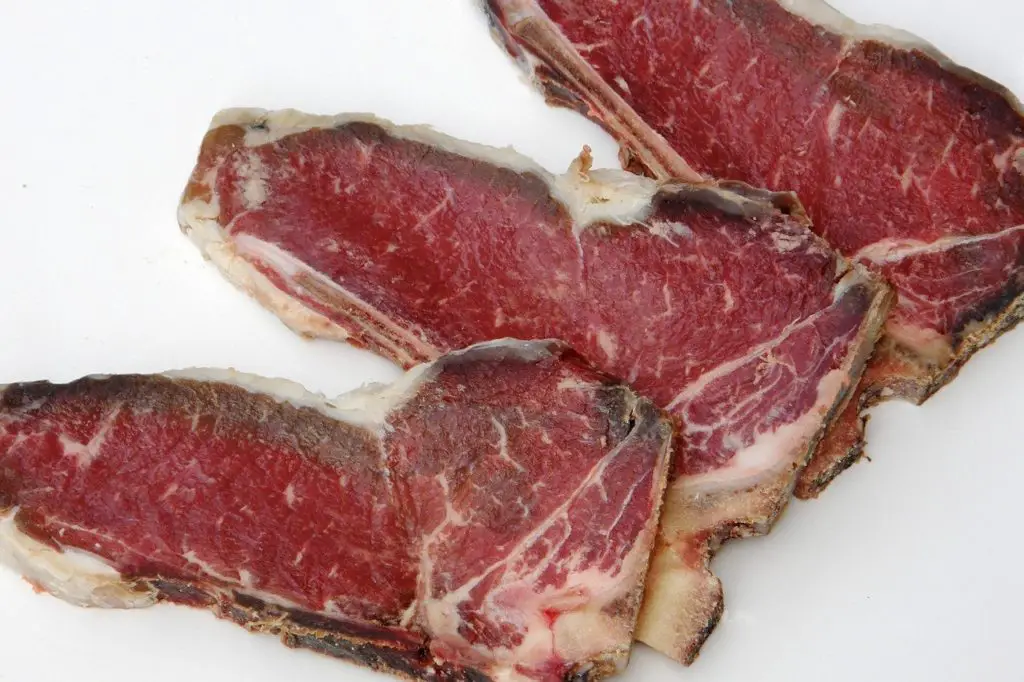Do you like your steaks rare, medium, or well-done?
Regardless of your preference, if you’re looking for the best steak experience, you should be trying dry-aged steak.
But what is dry aged steak? And how does it differ from other types of steak?
In this blog post, we will answer all of those questions and more!
We’ll discuss what dry aging is, how it affects meat, and the best cuts to try.
We’ll also explore why dry-aged steak is more expensive than other types of steak and whether or not you can do it at home.
Contents
- 1 What is dry aged steak?
- 2 What is dry aging?
- 3 How does dry-aged steak compare with wet-aged steak?
- 4 How does dry-aging change the taste and texture of meat?
- 5 What are the best cuts of dry-aged meats?
- 6 What’s the ideal time to dry-aged steak?
- 7 Why is dry-aged steak expensive?
- 8 Can you dry aging steak at home?
- 9 Summary
What is dry aged steak?
One of the most coveted cuts of steak, dry-aged beef is known for its intense flavor and tender texture.
Dry-aged steak is made from primal cuts of beef that have been aged in a controlled environment for a period of time, typically between 21 and 28 days.
During this aging process, the beef is exposed to carefully controlled temperatures and humidity levels.
This causes the steak to lose moisture, resulting in a more concentrated flavor.
The dry-aging process also helps to break down tough connective tissues, making the steak more tender.
While dry-aged steak is more expensive than its wet-aged counterpart, many steak connoisseurs believe that the extra cost is well worth it.
What is dry aging?
Dry aging is a meat aging process that involves exposing the meat to a controlled environment with low humidity and circulation of air.
Over a period of weeks or months, this exposure allows the natural enzymes in the meat to break down the connective tissue, resulting in a more tender and flavorful product.
Dry-aged beef is often considered superior in taste and texture to beef that has been aged using other methods, such as wet aging (which involves sealing the meat in a vacuum-sealed bag).
While dry aging does have some potential drawbacks (such as the increased risk of bacterial contamination and higher loss of water content), many feel that the end result is worth the effort.
If you’re looking for the ultimate steak experience, dry-aged beef is definitely worth seeking out.
How does dry-aged steak compare with wet-aged steak?
When it comes to steak, there are two main types of aging: dry-aging and wet-aging.
Both methods have their own advantages and disadvantages, so it’s important to choose the right type of steak for your needs.
Dry-aged steak is typically more expensive than wet-aged steak, but it also has a more intense flavor.
This is because dry-aging allows the steak to lose moisture, concentrating the flavors.
Wet-aging, on the other hand, tenderizes the steak while still retaining moisture.
As a result, wet-aged steak is usually juicy and easier to cook than dry-aged steak.
Ultimately, the best type of steak for you will depend on your personal preferences.
If you’re looking for a more flavorful steak, dry-aging is the way to go.
But if you’re looking for a juicier, more forgiving steak, wet-aging is the better option.
How does dry-aging change the taste and texture of meat?
Dry-aging is a method of meat preparation that involves allowing the meat to sit in a controlled environment for a period of time, typically two weeks or more.
During this time, the meat will lose moisture and its flavor will concentrate.
The taste of dry-aged meat is often described as being more intense and complex than that of fresh meat, with notes of nuttiness, Umami, and caramelization.
In addition, dry-aging also alters the texture of the meat, making it more tender and flavorful.
While dry-aging is more commonly associated with the steak, it can be used to improve the flavor and texture of other cuts of meat as well.
When done properly, dry-aging can produce truly remarkable results.
What are the best cuts of dry-aged meats?
When it comes to dry-aged meats, there are a few key cuts that are prized by chefs and home cooks alike.
The ribeye is perhaps the most popular choice, as its rich flavor and tender texture make it ideal for steak night.
Another top pick is the New York strip, which is equally flavorful and slightly leaner.
Another excellent option is the porterhouse, which combines both the ribeye and the New York strip in one juicy cut.
Lastly, the filet mignon is widely considered to be the king of dry-aged meats, thanks to its unbeatable flavor and melt-in-your-mouth texture.
No matter which cut you choose, dry-aged meats are sure to elevate your next meal.
What’s the ideal time to dry-aged steak?
The ideal time to dry-age meat is typically between 14 and 21 days.
This timeframe allows the enzymes in the meat to break down the tough connective tissue, resulting in a more tender and flavorful steak.
Additionally, the longer the meat is aged, the more pronounced the flavor will be.
However, it’s important to not overdo it, as the meat can become too dry and crumbly if left to age for too long.
If you’re uncertain how long to age your steak, err on the side of caution and start with a shorter timeframe.
You can always let it age longer if you find that the flavor isn’t quite pronounced enough.
With a little trial and error, you’ll soon find the perfect balance of flavor and tenderness for your taste buds.
Why is dry-aged steak expensive?
When it comes to steak, there are many factors that affect quality and taste.
One of the most important is the age of the meat.
Dry-aged steak is typically more expensive than wet-aged steak because the dry-aging process is more labor-intensive and results in a higher percentage of loss.
Dry-aged steak also has a more intense flavor, due to the breakdown of enzymes and evaporation of water.
The longer the meat is aged, the more intense the flavor will be.
In addition, dry-aged steak tends to be more tender than wet-aged steak.
For these reasons, dry-aged steak is typically considered to be of higher quality than wet-aged steak and is thus more expensive.
You might also like: How To Dry Age A Steak At Home
Can you dry aging steak at home?
Drying an aging steak is a long process that involves exposing the meat to a controlled environment.
This environment must have specific temperature, humidity, and ventilation levels.
The most important factor in determining the success of aging steak is the temperature.
Too high of a temperature will cause the meat to spoil, while too low of a temperature will prevent the desired breakdown of proteins.
In terms of humidity, too much moisture will cause the growth of mold, while too little moisture will cause the meat to dry out.
Lastly, proper ventilation is essential to prevent the build-up of bacteria.
While it is possible to create this controlled environment at home, it is difficult to do so without specialized equipment.
For this reason, most people choose to purchase pre-aged steak from a butcher or grocery store.
Summary
Dry-aged steak is a type of meat that has been aged in a controlled environment.
This process results in a more tender and flavorful steak.
Dry-aged steak is typically more expensive than wet-aged steak, due to the higher percentage of loss during the aging process.
Additionally, dry-aged steak has a more intense flavor than wet-aged steak.
The ideal time to dry-age meat is typically between 14 and 21 days.
Most people choose to purchase pre-aged steak from a butcher or grocery store, as it is difficult to create a necessarily controlled environment at home.

